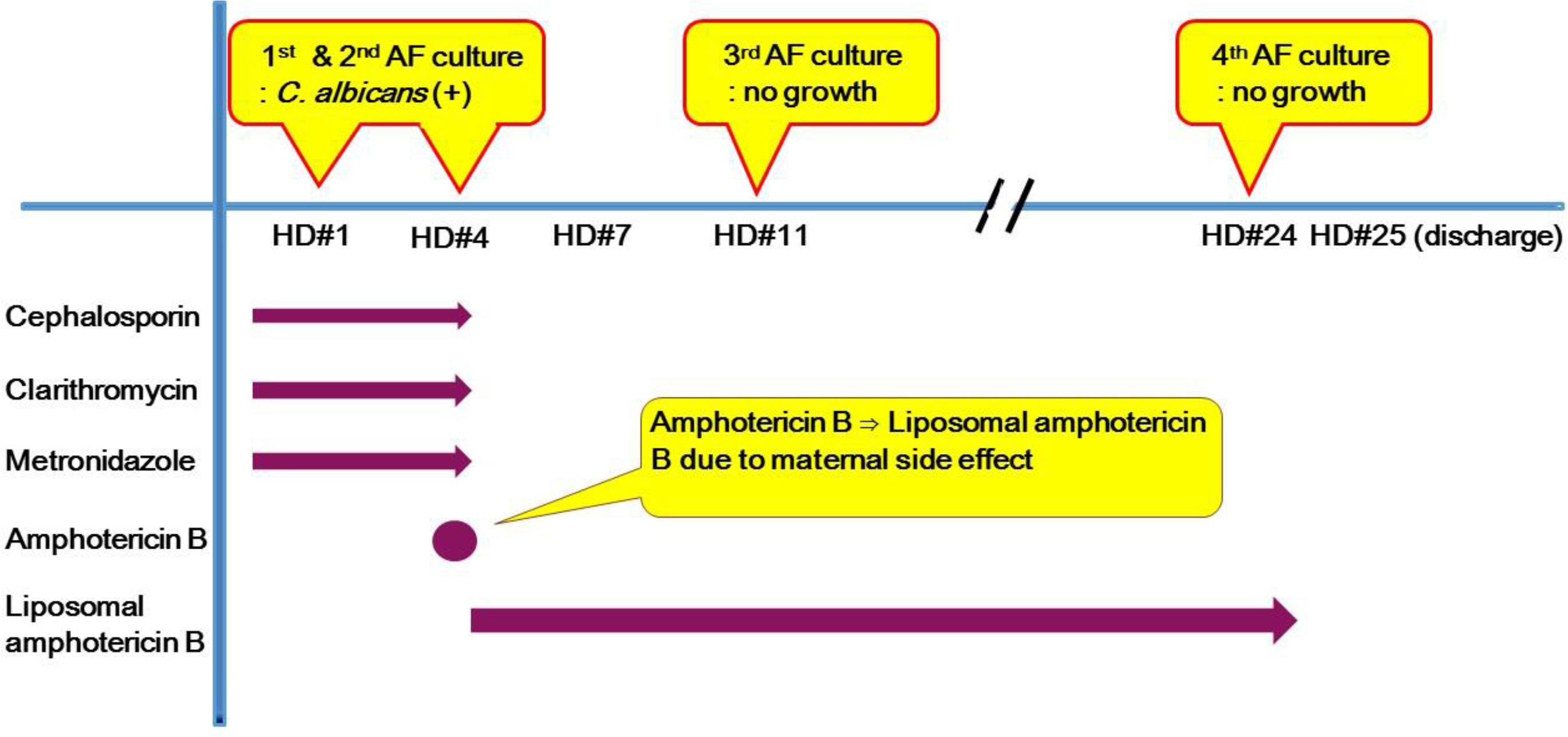Perinatology.
2017 Sep;28(3):99-102. 10.14734/PN.2017.28.3.99.
Intra-Amniotic Candida Infection Treated by Liposomal Amphotericin B in a Patient with Cervical Insufficiency
- Affiliations
-
- 1Department of Obstetrics and Gynecology, Jeju National University School of Medicine, Jeju, Korea.
- 2Department of Obstetrics and Gynecology, Jeju National University Hospital, Jeju, Korea. jwjwpark@gmail.com
- 3Department of Obstetrics and Gynecology, Chung-Ang University College of Medicine, Seoul, Korea.
- 4Department of Obstetrics and Gynecology, Inje University Ilsan Paik Hospital, Inje University College of Medicine, Goyang, Korea.
- KMID: 2392431
- DOI: http://doi.org/10.14734/PN.2017.28.3.99
Abstract
- Intra-amniotic Candida infection is uncommon but the consequence can be catastrophic. Transcervical amphotericin B and intra-amniotic fluconazole administration were identified in the literature. We present a case with intact membranes and ongoing pregnancy treated by maternal intravenous liposomal amphotericin B. A primipara who underwent cerclage placement before fetal viability was diagnosed with intra-amniotic Candida infection. Although maternal intravenous liposomal amphotericin B eradicated fungi in the amniotic cavity, Escherichia coli invasion caused devastating chorioamnionitis. The newborn delivered at 27⺳ weeks' gestation did not survive due to respiratory distress syndrome and sepsis. Despite negative conversion of intra-amniotic culture results for fungi after treatment, another pathogen such as bacteria could ascend into the amniotic cavity via weakened membranes. Clinicians should consider broad-spectrum antibiotics as well as antifungal agents in this setting.
Keyword
MeSH Terms
Figure
Reference
-
1). Chaim W., Mazor M., Wiznitzer A. The prevalence and clinical significance of intraamniotic infection with candida species in women with preterm labor. Arch Gynecol Obstet. 1992. 251:9–15.
Article2). Roqué H., Abdelhak Y., Young BK. Intra amniotic candidiasis. Case report and meta-analysis of 54 cases. J Perinat Med. 1999. 27:253–62.
Article3). Shalev E., Battino S., Romano S., Blondhaim O., Ben-Ami M. Intraamniotic infection with candida albicans successfully treated with transcervical amnioinfusion of amphotericin. Am J Obstet Gynecol. 1994. 170(5 Pt 1):1271–2.
Article4). Bean LM., Jackson JR., Dobak WJ., Beiswenger TR., Thorp JA. Intra-amniotic fluconazole therapy for candida albicans intra-amniotic infection. Obstet Gynecol. 2013. 121(2 Pt 2 Suppl 1):452–4.5). Lee SE., Romero R., Park CW., Jun JK., Yoon BH. The frequency and significance of intraamniotic inflammation in patients with cervical insufficiency. Am J Obstet Gynecol. 2008. 198:633. .e1-8.
Article6). Dean JL., Wolf JE., Ranzini AC., Laughlin MA. Use of amphotericin B during pregnancy: case report and review. Clin Infect Dis. 1994. 18:364–8.
Article7). Kim CJ., Romero R., Chaemsaithong P., Chaiyasit N., Yoon BH., Kim YM. Acute chorioamnionitis and funisitis: definition, pathologic features, and clinical significance. Am J Obstet Gynecol. 2015. 213(4 Suppl):S29–52.
Article8). Pilmis B., Jullien V., Sobel J., Lecuit M., Lortholary O., Charlier C. Antifungal drugs during pregnancy: an updated review. J Antimicrob Chemother. 2015. 70:14–22.
Article9). Vlachadis N., Iliodromiti Z., Vrachnis N. Oral fluconazole during pregnancy and risk of birth defects. N Engl J Med. 2013. 369:2061–2.
Article
- Full Text Links
- Actions
-
Cited
- CITED
-
- Close
- Share
- Similar articles
-
- Successful Long Term Antifungal Agent Therapy for Renal Candidiasis without Surgical Drainage in a Very Low Birth Weight Infant
- Successful Treatment of Candida albicans Endocarditis with Liposomal Amphotericin B (AmBisome(R)) in a Very Low Birth Weight Infant
- A Case of Extremely Premature Baby with Persistent Metabolic Acidosis, Hypoglycemia and Dyselectrolytemia Induced by Liposomal Amphotericin B
- A Case of Disseminated Fusarium Infection Treated by Liposomal Amphotericin B in a Leukemic Patient
- A Case of Candida Endophthalmitis


